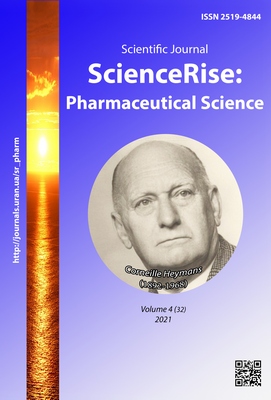Theoretical study of the possibility of decamethoxin complexes with thiotriazolinе to be formed
DOI:
https://doi.org/10.15587/2519-4852.2021.239279Keywords:
thiotriazoline, decamethoxine, molecular compounds, diseases, quantum chemical calculations, interaction energyAbstract
Over the last decade, much attention has been paid to the prevention and treatment of chronic diseases of the oral mucosa.
This is primarily due to the increase in the number of patients who seek dental care for diseases of the oral mucosa (DOM).
Currently, due to the lack of special epidemiological studies, information on the pathology of the oral mucosa in the literature is almost non-existent. The etiology and pathogenesis have not been definitively elucidated. It is established that a significant role in the pathogenesis of chronic inflammatory processes belongs to the state of the microbiocenosis of the oral mucosa.
One of the most striking examples of domestic drugs of the antioxidant group is thiotriazoline, developed by the staff of the NGO “Pharmatron”, as well as specialists of the Department of Pharmaceutical Chemistry of Zaporozhye State Medical University under the leadership of professor Mazur I. A. This drug has an antioxidant and membrane-stabilizing effect.
The aim. The combined use of several drugs can be complicated by the formation of their supramolecular complexes. Therefore, before the introduction of several substances in it is necessary to model the possibility of intermolecular interactions between them. For this purpose, methods of quantum chemistry are used.
Material and methods. We examined the structures and energy characteristics of the complexes, formed thiotriazoline and decamethoxin, also carried out analysis and established at what temperature the formation of a substance from two active components was possible.
Results. As a result, the probability of the formation of intermolecular hydrogen bonds is reduced, which is very well seen in the trend of interactions between acid and morpholine.
Conclusions. Quantum chemical study of a two-component system consisting of thiotriazoline and decamethoxine showed that the most energetically advantageous three-component complexes have a sufficiently low interaction energy of thiotriazoline and decamethoxine. In addition, the data that are provided in the analysis of the tree diagram suggest that in the technological process in the manufacture of dosage forms, it is advisable to use a temperature not higher than 115℃.
References
- Neese, F. (2011). The ORCA program system. WIREs Computational Molecular Science, 2 (1), 73–78. doi: http://doi.org/10.1002/wcms.81
- Zubatyuk, R. I., Kucherenko, L. I., Mazur, I. A., Khromyleva, O. V., Shishkin, O. V. (2014). A Theoretical Structural Study of Isoniazid Complexes with Thiotriazoline. Chemistry of Heterocyclic Compounds, 50 (3), 438–443. doi: http://doi.org/10.1007/s10593-014-1493-4
- Kruse, H., Grimme, S. (2012). A geometrical correction for the inter- and intra-molecular basis set superposition error in Hartree-Fock and density functional theory calculations for large systems. The Journal of Chemical Physics, 136 (15), 154101. doi: http://doi.org/10.1063/1.3700154
- Kucherenko, L. I., Borsuk, S. O., Belenichev, I. F., Mazur, I. A., Stebliuk, V. S. (2016). Pat. No. 112513 UA. Combined drug with anxiolytic, stress-protective, nootropic and antioxidant action. MPK: IPC (2016), А61К 31/405 (2006.01) А61К 31/41 (2006.01) А61 Р 25/00 А61Р 25/28 (2006.01). No. а201604961; declared 04.05.2016; published: 24.06.16, Bull. No. 12.
- Zubatyuk, R. I., Kucherenko, L. I., Mazur, I. A., Khromyleva, O. V., Shishkin, O. V. (2014). A Theoretical Structural Study of Isoniazid Complexes with Thiotriazoline. Chemistry of Heterocyclic Compounds, 50 (3), 438–443. doi: http://doi.org/10.1007/s10593-014-1493-4
- Petersen, P. E., Bourgeois, D., Ogawa, H., Estupinan-Day, S., Ndiaye, C. (2015). The global burden of oral diseases and risks to oral health. Bull World Health Organ, 83 (9), 661–669.
- Chekman, I. S., Belenichev, I. F., Gorchakova, N. A. (2014). Antioxidants: clinical and pharmacological aspect. Ukrainian medical chronograph, 1, 22–28.
- Iglesias-Sancho, M., Llambí Mateos, F., Salleras-Redonnet, M. (2020). Formulación magistral en patología de la mucosa oral. Actas Dermo-Sifiliográficas, 111 (10), 822–828. doi: http://doi.org/10.1016/j.ad.2020.08.004
- Kruglyak, Yu. A. (2020). Quantum modeling in quantum chemistry. Odessa: TPP, 339.
- Osadko, I. S. (2018). Quantum dynamics of molecules interacting with photons, phonons and tunnel systems. Fizmatlit Publishing House. EBS Lan. Available at: https://e.lanbook.com/book/105025
- Kuznetsov, S. I., Leader, A. M. (2015). Physics. Wave optics. Quantum nature of radiation. Elements of atomic and nuclear physics. Мoscow: University textbook, SIC INFRA-M, 212. Available at: http://znanium.com/catalog/product/438135
- Codina, A., Iglesias-Sancho, M. (2017). Manual de formulación de medicamentos individualizados en mucosas. Acofarma distribución.
- Ma, Y., Liu, Y., Su, H., Wang, L., Zhang, J. (2018). Relationship between hydrogen bond and viscosity for a series of pyridinium ionic liquids: Molecular dynamics and quantum chemistry. Journal of Molecular Liquids, 255, 176–184. doi: http://doi.org/10.1016/j.molliq.2018.01.121
- Sánchez, J., Conejero, C., Conejero, R. (2020). Recurrent Aphthous Stomatitis. Actas Dermo-Sifiliográficas, 111 (6), 471–480. doi: http://doi.org/10.1016/j.adengl.2019.09.006
- Sawada, S., Chosa, N., Ishisaki, A., Naruishi, K. (2013). Enhancement of gingival inflammation induced by synergism of IL-1β and IL-6. Biomedical research, 34 (1), 31–40. doi: http://doi.org/10.2220/biomedres.34.31
Downloads
Published
How to Cite
Issue
Section
License
Copyright (c) 2021 Ludmila Kucherenko, Svetlana Shishkina, Elena Chonka

This work is licensed under a Creative Commons Attribution 4.0 International License.
Our journal abides by the Creative Commons CC BY copyright rights and permissions for open access journals.








